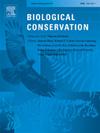Action- or results-based payments for ecosystem services in the era of smart weeding robots?
IF 4.9
1区 环境科学与生态学
Q1 BIODIVERSITY CONSERVATION
引用次数: 0
Abstract
Payments for ecosystem services (PES) are commonly used to reduce negative impacts on biodiversity by intensive agricultural production. Whether action- or results-based, the efficiency of PES schemes in terms of conservation benefit per costs, hinges on cost-effective monitoring, actions farmers are rewarded for, appropriate biodiversity indicators and, farmers' acceptance. Despite expectations that novel technologies, such as weeding robots, will reduce monitoring costs, the potential impact of their widespread use on optimal PES design for biodiversity conservation in arable farming remains unexplored. Our study investigates 1) the influence of weeding robots on optimal scheme design and 2) the challenges and options that arise for future PES scheme design. To this end, we use a simulation model to systematically compare how the availability of weeding robots changes the preferability of action-based versus results-based payments under various production and management conditions. This study sheds light on the transformative potential of weeding robots in optimising PES for biodiversity conservation. The results indicate that the difference in efficiency between action- and results-based schemes vanishes if robots can perform biodiversity-sensitive actions. Further, we find that it is even more important for the future design of PES to be able to define multidimensional biodiversity goals - a major challenge calling for interdisciplinary research.

求助全文
约1分钟内获得全文
求助全文
来源期刊

Biological Conservation
环境科学-环境科学
CiteScore
10.20
自引率
3.40%
发文量
295
审稿时长
61 days
期刊介绍:
Biological Conservation is an international leading journal in the discipline of conservation biology. The journal publishes articles spanning a diverse range of fields that contribute to the biological, sociological, and economic dimensions of conservation and natural resource management. The primary aim of Biological Conservation is the publication of high-quality papers that advance the science and practice of conservation, or which demonstrate the application of conservation principles for natural resource management and policy. Therefore it will be of interest to a broad international readership.
 求助内容:
求助内容: 应助结果提醒方式:
应助结果提醒方式:


